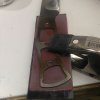Stromberg Knives
strombergknives.com
- Joined
- Jan 3, 2015
- Messages
- 856
I recently took delivery on a mini mill which I intend to use for both milling, drilling and tapping with a tapmatic.
I'm pretty familiar with how to setup for milling. But what would be the best setup for drilling semi precision holes on knife blanks?
My former drill press used a overhead clamping system so I didn't need a vise. It was very quick to setup and drill, unfortunately the drill press in itself wasn't rigid enough for my liking.
The mini mill is rigid enough, for drilling large and/or precision holes I can take the time and do a more precise setup, but for drilling pin holes in knife blanks, I need something quick and easy.
How would you do it? Some sort of drilling vice? Sacrificial piece underneath? Toggle clamps?

Thanks!
I'm pretty familiar with how to setup for milling. But what would be the best setup for drilling semi precision holes on knife blanks?
My former drill press used a overhead clamping system so I didn't need a vise. It was very quick to setup and drill, unfortunately the drill press in itself wasn't rigid enough for my liking.
The mini mill is rigid enough, for drilling large and/or precision holes I can take the time and do a more precise setup, but for drilling pin holes in knife blanks, I need something quick and easy.
How would you do it? Some sort of drilling vice? Sacrificial piece underneath? Toggle clamps?

Thanks!





